light FIAT DUCATO BASE CAMPER 2015 Owner handbook (in English)
[x] Cancel search | Manufacturer: FIAT, Model Year: 2015, Model line: DUCATO BASE CAMPER, Model: FIAT DUCATO BASE CAMPER 2015Pages: 367, PDF Size: 19.73 MB
Page 187 of 367
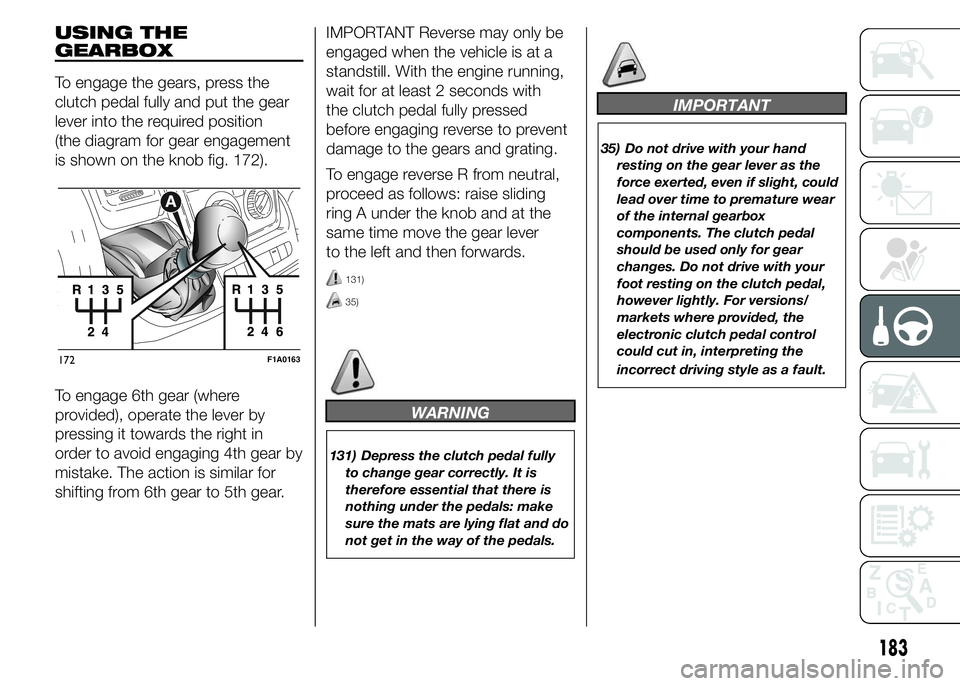
USING THE
GEARBOX
To engage the gears, press the
clutch pedal fully and put the gear
lever into the required position
(the diagram for gear engagement
is shown on the knob fig. 172).
To engage 6th gear (where
provided), operate the lever by
pressing it towards the right in
order to avoid engaging 4th gear by
mistake. The action is similar for
shifting from 6th gear to 5th gear.IMPORTANT Reverse may only be
engaged when the vehicle is at a
standstill. With the engine running,
wait for at least 2 seconds with
the clutch pedal fully pressed
before engaging reverse to prevent
damage to the gears and grating.
To engage reverse R from neutral,
proceed as follows: raise sliding
ring A under the knob and at the
same time move the gear lever
to the left and then forwards.
131)
35)
WARNING
131) Depress the clutch pedal fully
to change gear correctly. It is
therefore essential that there is
nothing under the pedals: make
sure the mats are lying flat and do
not get in the way of the pedals.
IMPORTANT
35) Do not drive with your hand
resting on the gear lever as the
force exerted, even if slight, could
lead over time to premature wear
of the internal gearbox
components. The clutch pedal
should be used only for gear
changes. Do not drive with your
foot resting on the clutch pedal,
however lightly. For versions/
markets where provided, the
electronic clutch pedal control
could cut in, interpreting the
incorrect driving style as a fault.
172F1A0163
183
Page 189 of 367
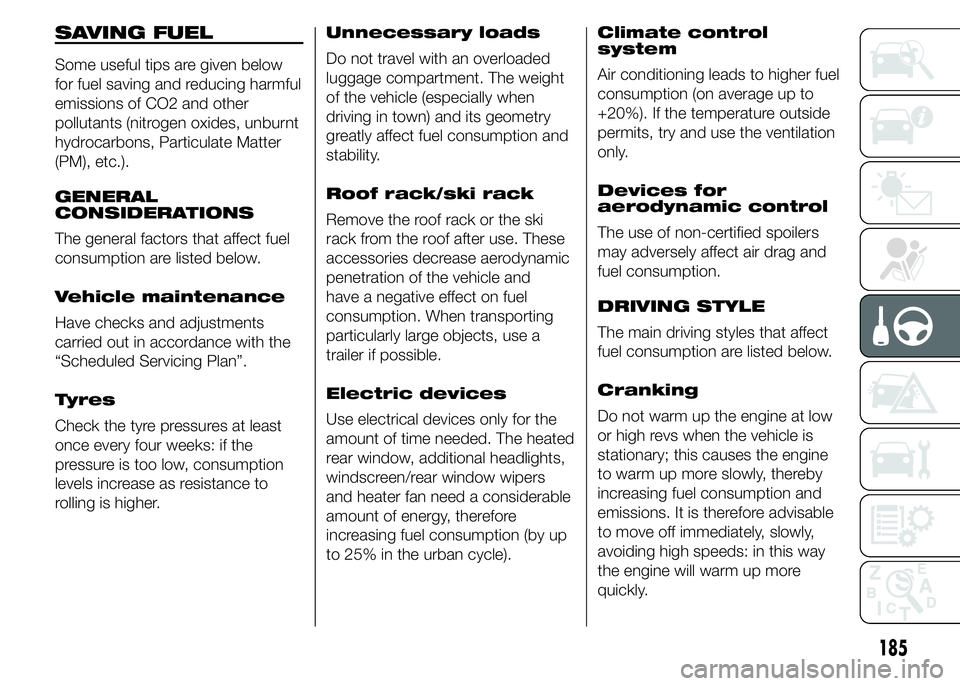
SAVING FUEL
Some useful tips are given below
for fuel saving and reducing harmful
emissions of CO2 and other
pollutants (nitrogen oxides, unburnt
hydrocarbons, Particulate Matter
(PM), etc.).
GENERAL
CONSIDERATIONS
The general factors that affect fuel
consumption are listed below.
Vehicle maintenance
Have checks and adjustments
carried out in accordance with the
“Scheduled Servicing Plan”.
Tyres
Check the tyre pressures at least
once every four weeks: if the
pressure is too low, consumption
levels increase as resistance to
rolling is higher.Unnecessary loads
Do not travel with an overloaded
luggage compartment. The weight
of the vehicle (especially when
driving in town) and its geometry
greatly affect fuel consumption and
stability.
Roof rack/ski rack
Remove the roof rack or the ski
rack from the roof after use. These
accessories decrease aerodynamic
penetration of the vehicle and
have a negative effect on fuel
consumption. When transporting
particularly large objects, use a
trailer if possible.
Electric devices
Use electrical devices only for the
amount of time needed. The heated
rear window, additional headlights,
windscreen/rear window wipers
and heater fan need a considerable
amount of energy, therefore
increasing fuel consumption (by up
to 25% in the urban cycle).Climate control
system
Air conditioning leads to higher fuel
consumption (on average up to
+20%). If the temperature outside
permits, try and use the ventilation
only.
Devices for
aerodynamic control
The use of non-certified spoilers
may adversely affect air drag and
fuel consumption.
DRIVING STYLE
The main driving styles that affect
fuel consumption are listed below.
Cranking
Do not warm up the engine at low
or high revs when the vehicle is
stationary; this causes the engine
to warm up more slowly, thereby
increasing fuel consumption and
emissions. It is therefore advisable
to move off immediately, slowly,
avoiding high speeds: in this way
the engine will warm up more
quickly.
185
Page 190 of 367
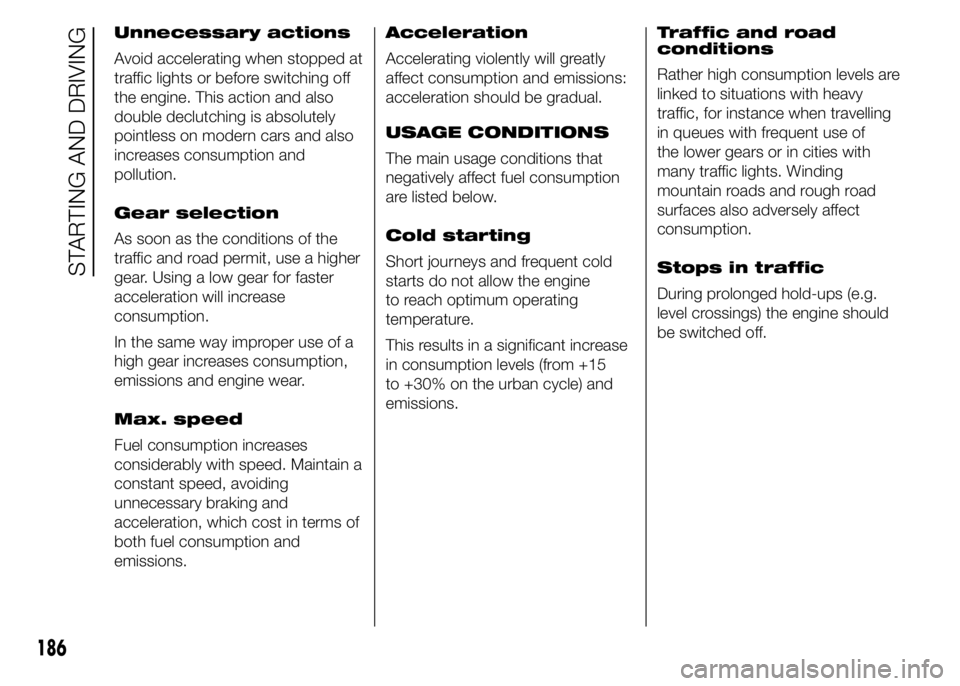
Unnecessary actions
Avoid accelerating when stopped at
traffic lights or before switching off
the engine. This action and also
double declutching is absolutely
pointless on modern cars and also
increases consumption and
pollution.
Gear selection
As soon as the conditions of the
traffic and road permit, use a higher
gear. Using a low gear for faster
acceleration will increase
consumption.
In the same way improper use of a
high gear increases consumption,
emissions and engine wear.
Max. speed
Fuel consumption increases
considerably with speed. Maintain a
constant speed, avoiding
unnecessary braking and
acceleration, which cost in terms of
both fuel consumption and
emissions.Acceleration
Accelerating violently will greatly
affect consumption and emissions:
acceleration should be gradual.
USAGE CONDITIONS
The main usage conditions that
negatively affect fuel consumption
are listed below.
Cold starting
Short journeys and frequent cold
starts do not allow the engine
to reach optimum operating
temperature.
This results in a significant increase
in consumption levels (from +15
to +30% on the urban cycle) and
emissions.Traffic and road
conditions
Rather high consumption levels are
linked to situations with heavy
traffic, for instance when travelling
in queues with frequent use of
the lower gears or in cities with
many traffic lights. Winding
mountain roads and rough road
surfaces also adversely affect
consumption.
Stops in traffic
During prolonged hold-ups (e.g.
level crossings) the engine should
be switched off.
186
STARTING AND DRIVING
Page 191 of 367
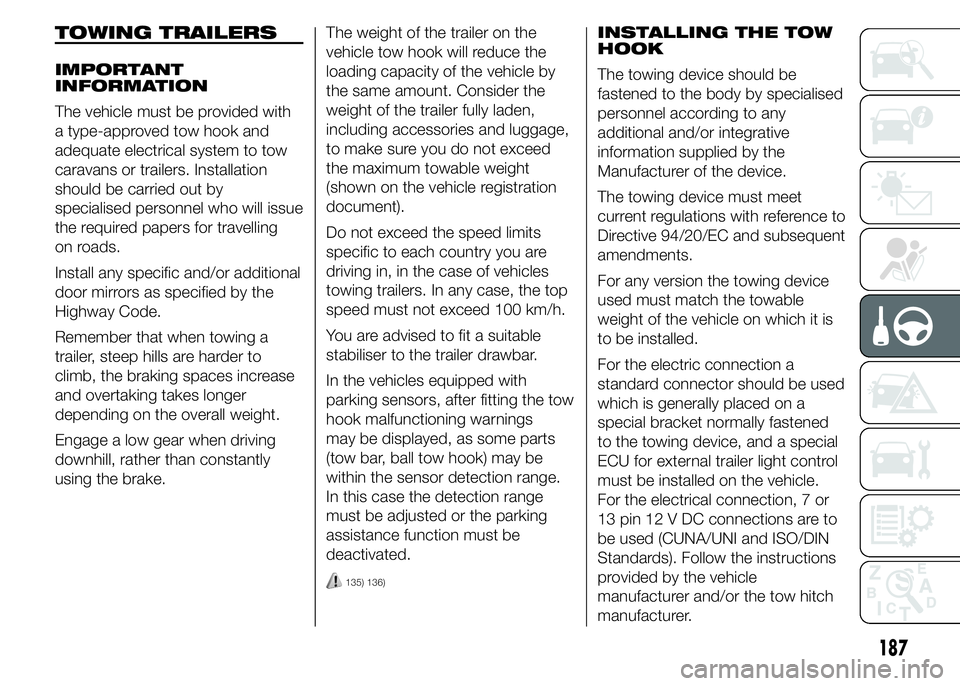
TOWING TRAILERS
IMPORTANT
INFORMATION
The vehicle must be provided with
a type-approved tow hook and
adequate electrical system to tow
caravans or trailers. Installation
should be carried out by
specialised personnel who will issue
the required papers for travelling
on roads.
Install any specific and/or additional
door mirrors as specified by the
Highway Code.
Remember that when towing a
trailer, steep hills are harder to
climb, the braking spaces increase
and overtaking takes longer
depending on the overall weight.
Engage a low gear when driving
downhill, rather than constantly
using the brake.The weight of the trailer on the
vehicle tow hook will reduce the
loading capacity of the vehicle by
the same amount. Consider the
weight of the trailer fully laden,
including accessories and luggage,
to make sure you do not exceed
the maximum towable weight
(shown on the vehicle registration
document).
Do not exceed the speed limits
specific to each country you are
driving in, in the case of vehicles
towing trailers. In any case, the top
speed must not exceed 100 km/h.
You are advised to fit a suitable
stabiliser to the trailer drawbar.
In the vehicles equipped with
parking sensors, after fitting the tow
hook malfunctioning warnings
may be displayed, as some parts
(tow bar, ball tow hook) may be
within the sensor detection range.
In this case the detection range
must be adjusted or the parking
assistance function must be
deactivated.
135) 136)
INSTALLING THE TOW
HOOK
The towing device should be
fastened to the body by specialised
personnel according to any
additional and/or integrative
information supplied by the
Manufacturer of the device.
The towing device must meet
current regulations with reference to
Directive 94/20/EC and subsequent
amendments.
For any version the towing device
used must match the towable
weight of the vehicle on which it is
to be installed.
For the electric connection a
standard connector should be used
which is generally placed on a
special bracket normally fastened
to the towing device, and a special
ECU for external trailer light control
must be installed on the vehicle.
For the electrical connection, 7 or
13 pin 12 V DC connections are to
be used (CUNA/UNI and ISO/DIN
Standards). Follow the instructions
provided by the vehicle
manufacturer and/or the tow hitch
manufacturer.
187
Page 192 of 367
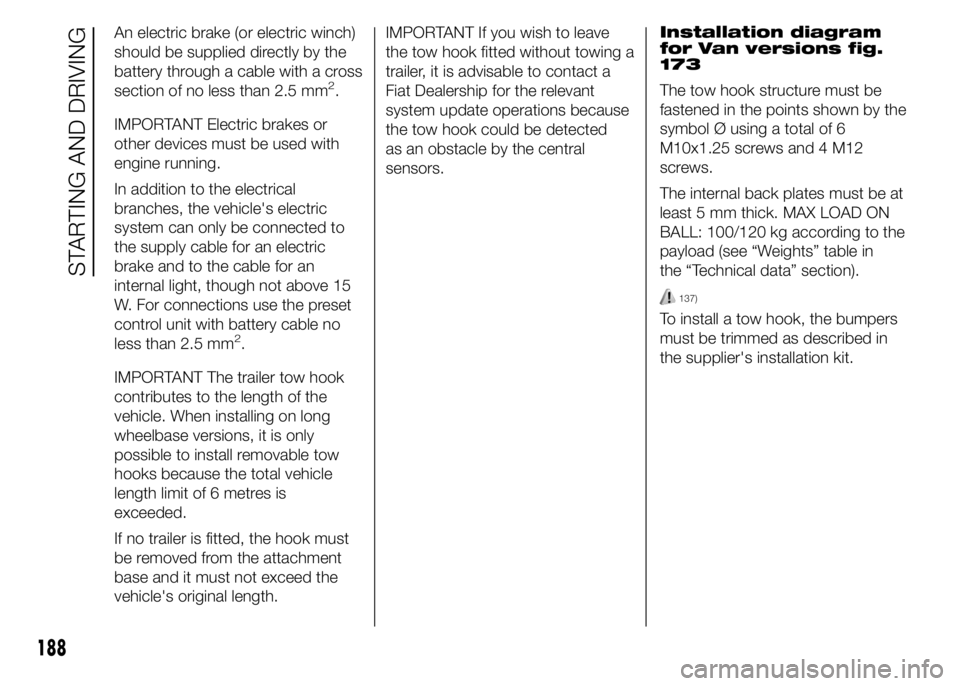
An electric brake (or electric winch)
should be supplied directly by the
battery through a cable with a cross
section of no less than 2.5 mm
2.
IMPORTANT Electric brakes or
other devices must be used with
engine running.
In addition to the electrical
branches, the vehicle's electric
system can only be connected to
the supply cable for an electric
brake and to the cable for an
internal light, though not above 15
W. For connections use the preset
control unit with battery cable no
less than 2.5 mm
2.
IMPORTANT The trailer tow hook
contributes to the length of the
vehicle. When installing on long
wheelbase versions, it is only
possible to install removable tow
hooks because the total vehicle
length limit of 6 metres is
exceeded.
If no trailer is fitted, the hook must
be removed from the attachment
base and it must not exceed the
vehicle's original length.IMPORTANT If you wish to leave
the tow hook fitted without towing a
trailer, it is advisable to contact a
Fiat Dealership for the relevant
system update operations because
the tow hook could be detected
as an obstacle by the central
sensors.Installation diagram
for Van versions fig.
173
The tow hook structure must be
fastened in the points shown by the
symbol Ø using a total of 6
M10x1.25 screws and 4 M12
screws.
The internal back plates must be at
least 5 mm thick. MAX LOAD ON
BALL: 100/120 kg according to the
payload (see “Weights” table in
the “Technical data” section).
137)
To install a tow hook, the bumpers
must be trimmed as described in
the supplier's installation kit.
188
STARTING AND DRIVING
Page 196 of 367
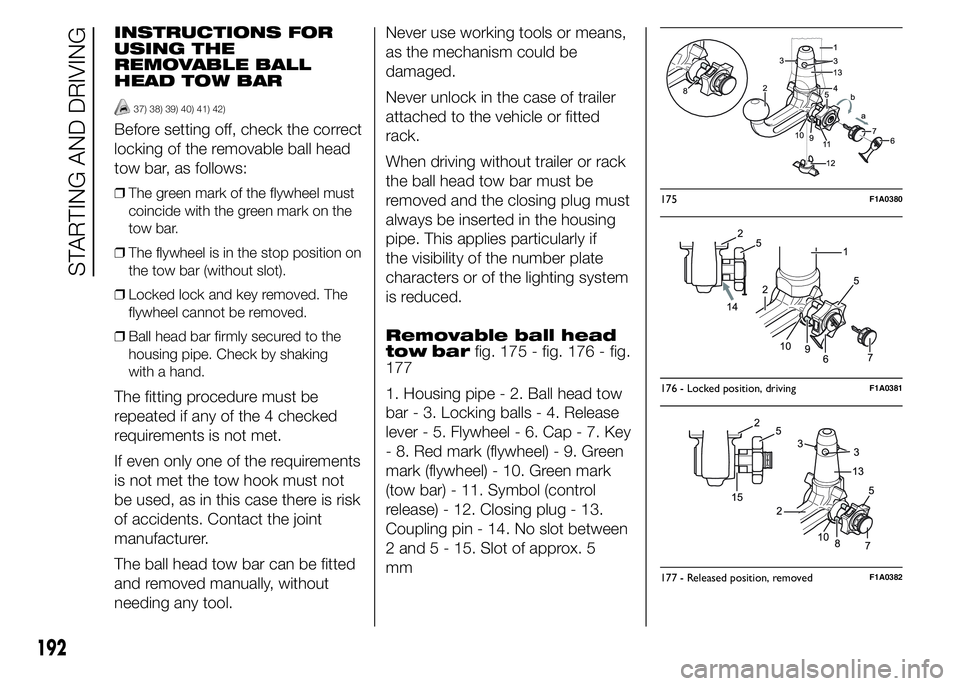
INSTRUCTIONS FOR
USING THE
REMOVABLE BALL
HEAD TOW BAR
37) 38) 39) 40) 41) 42)
Before setting off, check the correct
locking of the removable ball head
tow bar, as follows:
❒The green mark of the flywheel must
coincide with the green mark on the
tow bar.
❒The flywheel is in the stop position on
the tow bar (without slot).
❒Locked lock and key removed. The
flywheel cannot be removed.
❒Ball head bar firmly secured to the
housing pipe. Check by shaking
with a hand.
The fitting procedure must be
repeated if any of the 4 checked
requirements is not met.
If even only one of the requirements
is not met the tow hook must not
be used, as in this case there is risk
of accidents. Contact the joint
manufacturer.
The ball head tow bar can be fitted
and removed manually, without
needing any tool.Never use working tools or means,
as the mechanism could be
damaged.
Never unlock in the case of trailer
attached to the vehicle or fitted
rack.
When driving without trailer or rack
the ball head tow bar must be
removed and the closing plug must
always be inserted in the housing
pipe. This applies particularly if
the visibility of the number plate
characters or of the lighting system
is reduced.
Removable ball head
tow barfig. 175 - fig. 176 - fig.
177
1. Housing pipe - 2. Ball head tow
bar - 3. Locking balls - 4. Release
lever - 5. Flywheel - 6. Cap - 7. Key
- 8. Red mark (flywheel) - 9. Green
mark (flywheel) - 10. Green mark
(tow bar) - 11. Symbol (control
release) - 12. Closing plug - 13.
Coupling pin - 14. No slot between
2 and 5 - 15. Slot of approx. 5
mm
175F1A0380
176 - Locked position, drivingF1A0381
177 - Released position, removedF1A0382
192
STARTING AND DRIVING
Page 200 of 367
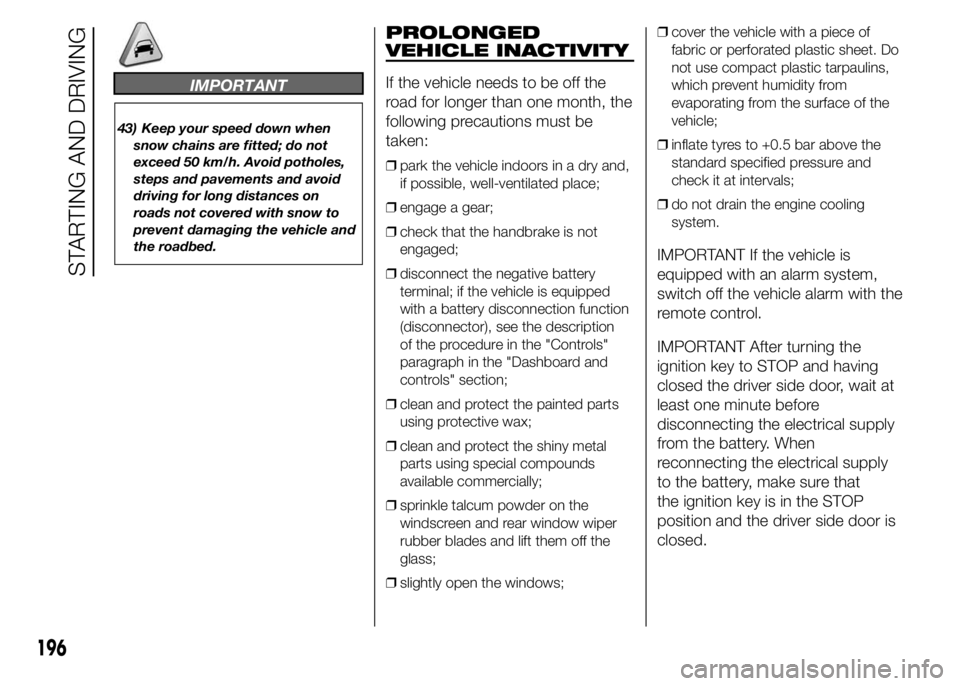
IMPORTANT
43) Keep your speed down when
snow chains are fitted; do not
exceed 50 km/h. Avoid potholes,
steps and pavements and avoid
driving for long distances on
roads not covered with snow to
prevent damaging the vehicle and
the roadbed.
PROLONGED
VEHICLE INACTIVITY
If the vehicle needs to be off the
road for longer than one month, the
following precautions must be
taken:
❒park the vehicle indoors in a dry and,
if possible, well-ventilated place;
❒engage a gear;
❒check that the handbrake is not
engaged;
❒disconnect the negative battery
terminal; if the vehicle is equipped
with a battery disconnection function
(disconnector), see the description
of the procedure in the "Controls"
paragraph in the "Dashboard and
controls" section;
❒clean and protect the painted parts
using protective wax;
❒clean and protect the shiny metal
parts using special compounds
available commercially;
❒sprinkle talcum powder on the
windscreen and rear window wiper
rubber blades and lift them off the
glass;
❒slightly open the windows;❒cover the vehicle with a piece of
fabric or perforated plastic sheet. Do
not use compact plastic tarpaulins,
which prevent humidity from
evaporating from the surface of the
vehicle;
❒inflate tyres to +0.5 bar above the
standard specified pressure and
check it at intervals;
❒do not drain the engine cooling
system.
IMPORTANT If the vehicle is
equipped with an alarm system,
switch off the vehicle alarm with the
remote control.
IMPORTANT After turning the
ignition key to STOP and having
closed the driver side door, wait at
least one minute before
disconnecting the electrical supply
from the battery. When
reconnecting the electrical supply
to the battery, make sure that
the ignition key is in the STOP
position and the driver side door is
closed.
196
STARTING AND DRIVING
Page 202 of 367
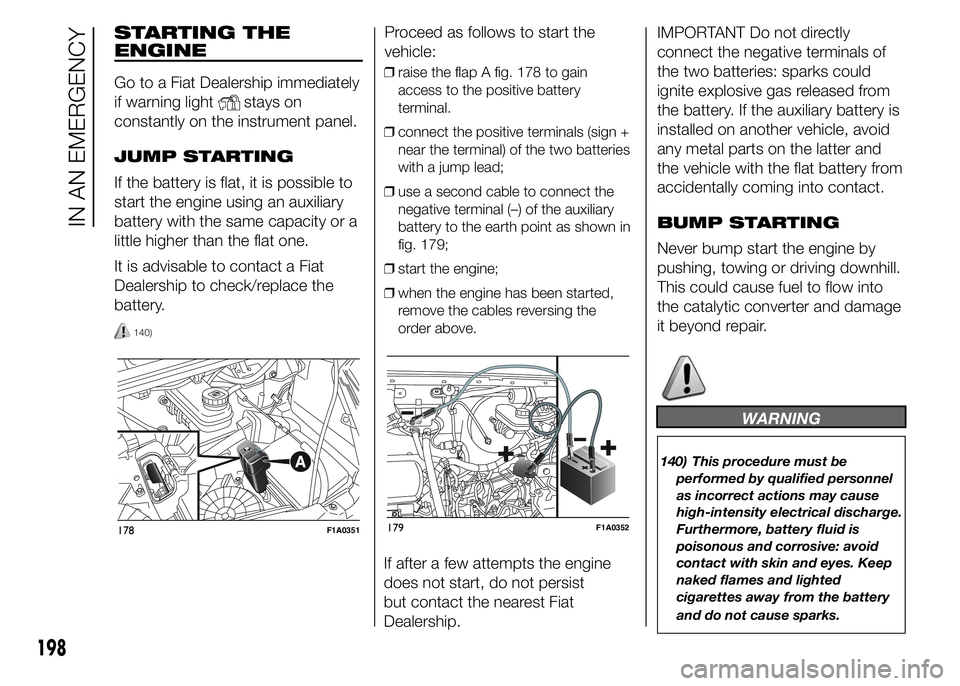
STARTING THE
ENGINE
Go to a Fiat Dealership immediately
if warning light
stays on
constantly on the instrument panel.
JUMP STARTING
If the battery is flat, it is possible to
start the engine using an auxiliary
battery with the same capacity or a
little higher than the flat one.
It is advisable to contact a Fiat
Dealership to check/replace the
battery.
140)
Proceed as follows to start the
vehicle:
❒raise the flap A fig. 178 to gain
access to the positive battery
terminal.
❒connect the positive terminals (sign +
near the terminal) of the two batteries
with a jump lead;
❒use a second cable to connect the
negative terminal (–) of the auxiliary
battery to the earth point as shown in
fig. 179;
❒start the engine;
❒when the engine has been started,
remove the cables reversing the
order above.
If after a few attempts the engine
does not start, do not persist
but contact the nearest Fiat
Dealership.IMPORTANT Do not directly
connect the negative terminals of
the two batteries: sparks could
ignite explosive gas released from
the battery. If the auxiliary battery is
installed on another vehicle, avoid
any metal parts on the latter and
the vehicle with the flat battery from
accidentally coming into contact.
BUMP STARTING
Never bump start the engine by
pushing, towing or driving downhill.
This could cause fuel to flow into
the catalytic converter and damage
it beyond repair.
WARNING
140) This procedure must be
performed by qualified personnel
as incorrect actions may cause
high-intensity electrical discharge.
Furthermore, battery fluid is
poisonous and corrosive: avoid
contact with skin and eyes. Keep
naked flames and lighted
cigarettes away from the battery
and do not cause sparks.
178F1A0351179F1A0352
198
IN AN EMERGENCY
Page 203 of 367
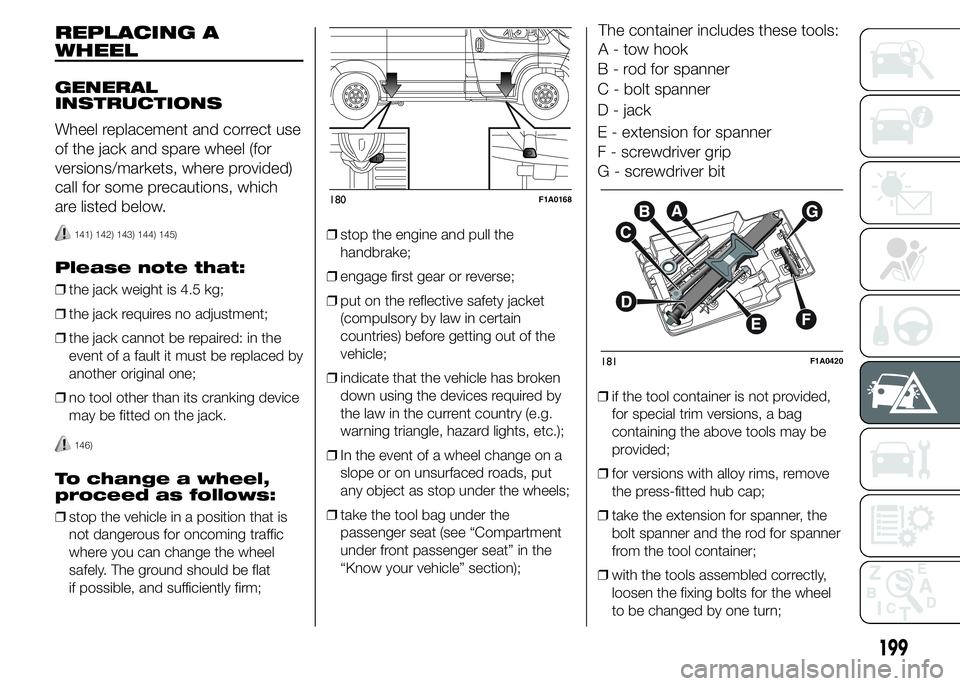
REPLACING A
WHEEL
GENERAL
INSTRUCTIONS
Wheel replacement and correct use
of the jack and spare wheel (for
versions/markets, where provided)
call for some precautions, which
are listed below.
141) 142) 143) 144) 145)
Please note that:
❒the jack weight is 4.5 kg;
❒the jack requires no adjustment;
❒the jack cannot be repaired: in the
event of a fault it must be replaced by
another original one;
❒no tool other than its cranking device
may be fitted on the jack.
146)
To change a wheel,
proceed as follows:
❒stop the vehicle in a position that is
not dangerous for oncoming traffic
where you can change the wheel
safely. The ground should be flat
if possible, and sufficiently firm;❒stop the engine and pull the
handbrake;
❒engage first gear or reverse;
❒put on the reflective safety jacket
(compulsory by law in certain
countries) before getting out of the
vehicle;
❒indicate that the vehicle has broken
down using the devices required by
the law in the current country (e.g.
warning triangle, hazard lights, etc.);
❒In the event of a wheel change on a
slope or on unsurfaced roads, put
any object as stop under the wheels;
❒take the tool bag under the
passenger seat (see “Compartment
under front passenger seat” in the
“Know your vehicle” section);
The container includes these tools:
A - tow hook
B - rod for spanner
C - bolt spanner
D - jack
E - extension for spanner
F - screwdriver grip
G - screwdriver bit
❒if the tool container is not provided,
for special trim versions, a bag
containing the above tools may be
provided;
❒for versions with alloy rims, remove
the press-fitted hub cap;
❒take the extension for spanner, the
bolt spanner and the rod for spanner
from the tool container;
❒with the tools assembled correctly,
loosen the fixing bolts for the wheel
to be changed by one turn;
180F1A0168
181F1A0420
199
Page 207 of 367
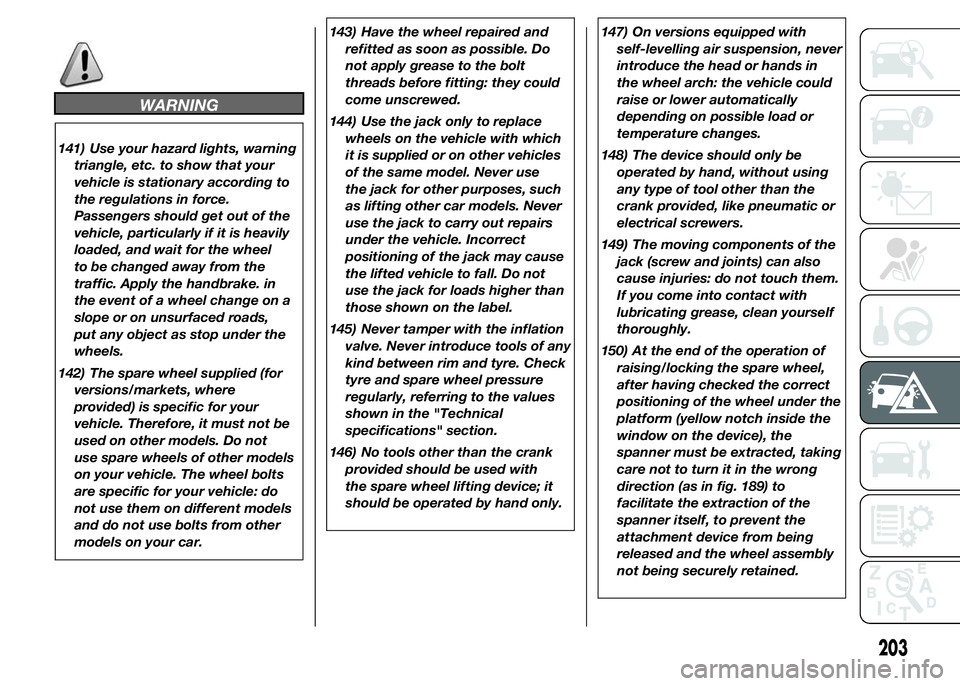
WARNING
141) Use your hazard lights, warning
triangle, etc. to show that your
vehicle is stationary according to
the regulations in force.
Passengers should get out of the
vehicle, particularly if it is heavily
loaded, and wait for the wheel
to be changed away from the
traffic. Apply the handbrake. in
the event of a wheel change on a
slope or on unsurfaced roads,
put any object as stop under the
wheels.
142) The spare wheel supplied (for
versions/markets, where
provided) is specific for your
vehicle. Therefore, it must not be
used on other models. Do not
use spare wheels of other models
on your vehicle. The wheel bolts
are specific for your vehicle: do
not use them on different models
and do not use bolts from other
models on your car.143) Have the wheel repaired and
refitted as soon as possible. Do
not apply grease to the bolt
threads before fitting: they could
come unscrewed.
144) Use the jack only to replace
wheels on the vehicle with which
it is supplied or on other vehicles
of the same model. Never use
the jack for other purposes, such
as lifting other car models. Never
use the jack to carry out repairs
under the vehicle. Incorrect
positioning of the jack may cause
the lifted vehicle to fall. Do not
use the jack for loads higher than
those shown on the label.
145) Never tamper with the inflation
valve. Never introduce tools of any
kind between rim and tyre. Check
tyre and spare wheel pressure
regularly, referring to the values
shown in the "Technical
specifications" section.
146) No tools other than the crank
provided should be used with
the spare wheel lifting device; it
should be operated by hand only.147) On versions equipped with
self-levelling air suspension, never
introduce the head or hands in
the wheel arch: the vehicle could
raise or lower automatically
depending on possible load or
temperature changes.
148) The device should only be
operated by hand, without using
any type of tool other than the
crank provided, like pneumatic or
electrical screwers.
149) The moving components of the
jack (screw and joints) can also
cause injuries: do not touch them.
If you come into contact with
lubricating grease, clean yourself
thoroughly.
150) At the end of the operation of
raising/locking the spare wheel,
after having checked the correct
positioning of the wheel under the
platform (yellow notch inside the
window on the device), the
spanner must be extracted, taking
care not to turn it in the wrong
direction (as in fig. 189) to
facilitate the extraction of the
spanner itself, to prevent the
attachment device from being
released and the wheel assembly
not being securely retained.
203